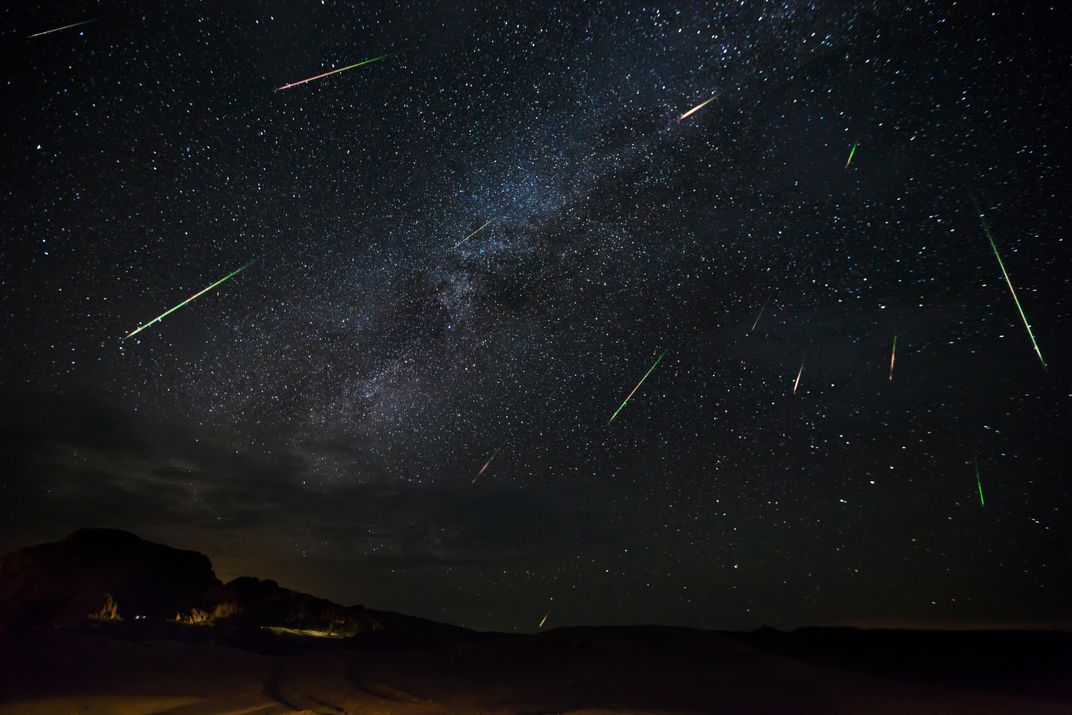How to Watch the Perseid Meteor Shower
Known for its ‘fireball’ meteors, the Perseid shower began on July 14 and will peak in mid-August
/https://tf-cmsv2-smithsonianmag-media.s3.amazonaws.com/filer/e3/9b/e39b65ab-a172-4e9d-ba3b-6d75e7d10bfd/gettyimages-1016195572.jpg)
July 14 marked the beginning of the Perseid meteor shower, widely considered the best meteor shower of the year, according to NASA.
Each summer, the Perseids grace the night sky with an incredible number of meteors—the bright streaks of light caused by bits of comet debris burning up in the high atmosphere. In 2021, the Perseids will reach their peak activity between August 11 and August 13. The best time to view the meteor shower will be in the hours between 2 a.m. and dawn.
At its most active, the meteor shower could have more than 100 visible meteors per hour, reports Josie Fischels for NPR. Combined with warm summer nights in the Northern Hemisphere, and the thin waxing crescent moon, stargazers can look forward to a fantastic show.
To have the best view of the meteor shower, find an area with minimal light pollution and settle in for the night. Your eyes will adjust to the darkness after a few minutes. Then, turn toward the constellation Perseus, which is where the meteors seem to shoot away from.

In fact, the meteor shower comes from the debris left behind 109PSwift-Tuttle, a large comet that makes a 133-year orbit that circles around the sun and reaches beyond Neptune. The comet leaves behind a trail of debris on its orbital path. When Earth passes through the debris cloud, bits of material between a few millimeters to a few inches across hit the atmosphere at about 133,200 miles per hour, explains Popular Science. The debris burns in the upper atmosphere, creating the visible streaks in the sky.
The Perseid meteor shower is especially well-known for having a lot of fireballs, which have an extra burst of light compared to the average meteor in a shower. Fireballs get at least as bright as how Jupiter and Venus appear in the night sky, according to NASA.
The Perseids have a lot of fireballs because the nucleus of the 109PSwift-Tuttle comet is about 16 miles wide, which is twice the size of the asteroid that may have wiped out the dinosaurs. The sizeable comet can create more large meteoroid debris than other comets, and those larger meteoroids burn brighter when they hit the atmosphere compared to smaller debris.
Because the meteor shower is so active and has a high frequency of bright fireballs, stargazers will be able to spot meteors as early as 9 p.m. in the northern hemisphere and about midnight in the southern hemisphere, especially if viewing from a location far from city lights. Early in the night, people can also look for “earth grazer” meteors, which appear to shoot just above the horizon, slower and more colorful than higher-up meteors, reports Sophie Lewis for CBS News.
When the Perseids peak on August 12, the moon will be in a waxing crescent and only about 13 percent illuminated, so it shouldn’t interfere too much with the meteor shower-viewing experience.
If weather interferes with peak night viewing, stargazers should be able to spot the Perseids until August 24. NASA also runs a meteor watch Facebook page, where people can keep up with exciting fireballs or tune in to livestream watch parties.
Otherwise, the next upcoming meteor shower is the Orionids in October, followed by the Geminids in December, which offers some of the brightest meteors for stargazers willing to brave the cold.